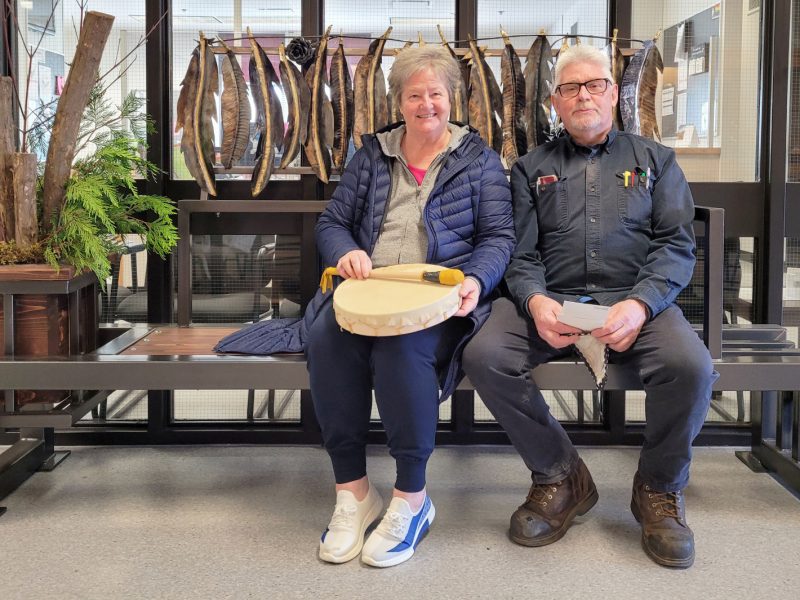
For the past seven years, TRU welding Instructor Jim McCarthy has also been teaching welding/art at NorKam Secondary. McCarthy recently created a bench for an Indigenous garden at NorKam, an example of art meeting trades skills, together building a symbol of reconciliation. On April 6, there was a blessing ceremony for the bench. Here are his words about the project.
As a welder and artist who got his start as a 15-year-old apprentice in the early ‘70s, my goal when I began teaching was to pass on my skills using art as inspiration. Once you introduce the art of the trades to youth, practical skills will follow.
For the past seven years, NorKam has become a second home. I am privileged to teach young students, demonstrating how the trades can help you take the next step in moving forward in life — as they did for me. In my years of teaching welding, I have discovered that Indigenous students have a natural inclination to art, which I love to witness. Every success is born of creativity and collaboration, and this bench is an example of that.
When NorKam school personnel asked me to create a piece for the Indigenous garden, it was important as a settler to proceed with humility and openness. I thought it was essential to first meet with the First Nations students of NorKam and ask for their input and ideas. They shared meaningful accounts of their culture and spirit animals. They pointed me to a sign in the school hallway that displayed 17 feathers — one for each of the 17 communities of the Secwépemc Nation. The students shared the importance of storytelling and communication, which brought me to the idea of a storytelling bench.

I envisioned the bench as a meeting place to sit and tell stories, honouring the vision and ideas of the students and the history of the traditional peoples. All parts of the bench are materials from the earth: steel, wood, animals and flowers — symbols of strength, resilience, renewal and transformation. The steel frame provides a supportive place to gather, and the feathers provide the backrest and inspiration for building solid relationships with one another.
At one end of the bench is a waterfall crafted in steel and highlighted with a salmon to represent the sacred importance of the land. A cedar box is located at the other end of the bench, designed to hold conversational treasures and gifts.
As the grandfather to three children of the Kaska-Dene Nation, I have experienced firsthand the intergenerational struggles faced by the Indigenous peoples of Canada, especially those whose direct and recent ancestors experienced the horrors and after-effects of the residential school system and Sixties Scoop. When the children’s graves were discovered mid-construction, the bench naturally evolved. I added two roses to the piece, representing our collective tears and a tiny caterpillar symbolizing the call for transformation and reconciliation.
I hope that this bench serves as a place for both grief and hope — as a place for gathering, telling stories, honouring the past, righting our wrongs and imagining a better future. Through my trade, I have the opportunity to show that the work of the hands is transformational. That work becomes the vocation of the heart and, therefore, the vocation of healing. I have learned from my family, from the students of NorKam, and from the Indigenous peoples of the Secwépemc that everything starts with communication, humility and gratitude.
I am grateful and humbled by the opportunity to share my art in service to the message of hope and healing. My thanks to collaborators Tim and Tulley, TRU carpentry instructors, TRU School of Trades employee Arie Groenendyk, who installed the cedar onsite, Quentin Robinson, who built the planter, NorKam personnel for encouraging the teamwork and creativity present in this piece, and especially to the Secwépemc First Nation, who continues to inspire me with their ideas and art every day.
I look forward to future collaborations, conversations and storytelling.
 Student's killer on parole
Student's killer on parole Charges after investigation
Charges after investigation Hostage was on captor
Hostage was on captor  Regulating power prices
Regulating power prices Gen X is raking it in
Gen X is raking it in LeBlanc laying groundwork
LeBlanc laying groundwork US vetoes UN resolution
US vetoes UN resolution $100M Nassar settlement
$100M Nassar settlement 12 Trump jurors picked
12 Trump jurors picked Rates slow green economy
Rates slow green economy Vicinity hires president,
Vicinity hires president, Record housing starts
Record housing starts Warriors ready for Round 2
Warriors ready for Round 2 Kalamalka Bowl cancelled
Kalamalka Bowl cancelled Rockets live to fight on
Rockets live to fight on Rihanna's parenting ‘hack’
Rihanna's parenting ‘hack’ Tarantino scraps film
Tarantino scraps film Munn talks cancer battle
Munn talks cancer battle



